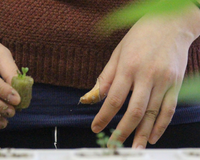While indoor hydroponic gardening offers numerous benefits, such as controlled environments and year-round cultivation, it is not without its challenges. Like any gardening method, hydroponics can encounter problems that affect plant health and growth. In this blog, we will explore some common issues that hydroponic gardeners may encounter and provide practical solutions to help troubleshoot and overcome these challenges.
Nutrient Imbalances:
Maintaining the proper balance of nutrients in your hydroponic system is crucial for healthy plant growth. Imbalances can lead to stunted growth, leaf discoloration, or nutrient deficiencies. Here's what you can do:
-
Regularly monitor pH levels: Ensure that the pH of your nutrient solution is within the optimal range for the specific plants you are growing. Adjust the pH using pH-up or pH-down solutions to maintain the ideal balance.
-
Adjust nutrient strength: Measure the electrical conductivity (EC) of your nutrient solution to determine its strength. Follow the recommended guidelines for the specific crop you are growing and adjust the nutrient concentration accordingly.
-
Flush the system: If you suspect a nutrient buildup or imbalance, flush your hydroponic system with pH-balanced water to remove excess salts or nutrients. Then, gradually reintroduce the nutrient solution at the correct strength.
-
Temperature control: Install a thermostat or temperature controller to regulate the temperature within your grow area. Optimal temperature ranges vary by plant species, so research and adjust accordingly.
-
Humidity management: Use a hygrometer to monitor humidity levels. If the humidity is too high, consider using a dehumidifier or improving air circulation. On the other hand, if the humidity is too low, use a humidifier or place water trays to increase moisture levels.
-
Ventilation and airflow: Proper ventilation is essential to maintain a steady supply of fresh air. Use fans or an exhaust system to circulate air and prevent stagnant conditions that can promote fungal growth or pest infestations.
-
Monitor regularly: Inspect your plants regularly for signs of pests. Look for visible pests, discolored leaves, or sticky residue on leaves, which can indicate an infestation.
-
Natural predators: Introduce beneficial insects like ladybugs or predatory mites, which feed on common pests. They provide a natural and effective solution for pest control.
-
Organic pest control: Use organic insecticidal soaps or neem oil to target pests without harming beneficial insects or plants. Follow the instructions carefully and apply treatments as needed.
Poor Root Health:
-
Oxygenation: Ensure that your hydroponic system provides adequate oxygenation to the roots. Oxygenate the nutrient solution with air stones or use oxygen pumps to maintain oxygen levels and prevent root suffocation.
-
Sterile environment: Maintain a clean and sterile growing environment to prevent the spread of pathogens. Regularly sanitize your system, including pumps, reservoirs, and any equipment, using appropriate cleaning agents.
-
Root zone temperature: Keep the root zone at an optimal temperature to promote healthy root growth. Avoid extreme temperature fluctuations that can stress the roots and hinder their development.
Conclusion:
Troubleshooting common issues in indoor hydroponic gardens is an essential part of maintaining a thriving and productive system. By addressing nutrient imbalances, managing temperature and humidity fluctuations, combating pest infestations, and promoting root health, you can overcome challenges and ensure the success of your hydroponic garden. Remember that each plant species has unique requirements, so research and adjust accordingly. With a little patience and knowledge, you'll be well on your way to a flourishing indoor hydroponic garden.








